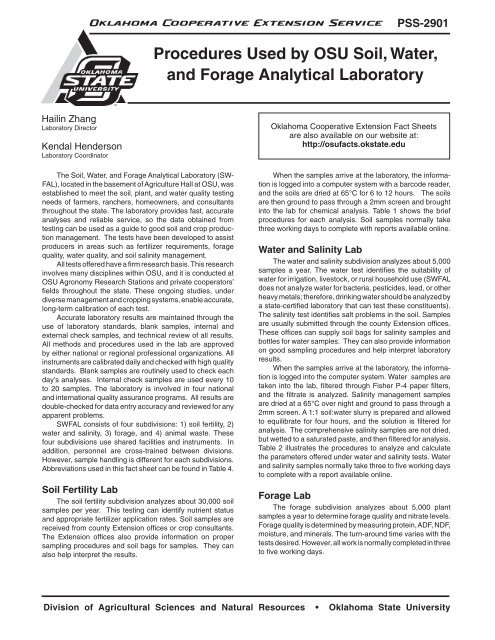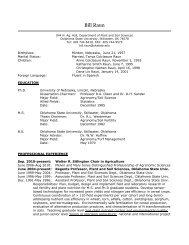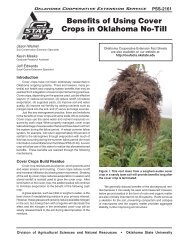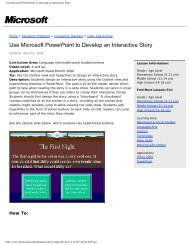PSS-2901 Procedures Used by OSU Soil, Water ... - OSU Fact Sheets
PSS-2901 Procedures Used by OSU Soil, Water ... - OSU Fact Sheets
PSS-2901 Procedures Used by OSU Soil, Water ... - OSU Fact Sheets
You also want an ePaper? Increase the reach of your titles
YUMPU automatically turns print PDFs into web optimized ePapers that Google loves.
Oklahoma Cooperative Extension Service<strong>PSS</strong>-<strong>2901</strong><strong>Procedures</strong> <strong>Used</strong> <strong>by</strong> <strong>OSU</strong> <strong>Soil</strong>, <strong>Water</strong>,and Forage Analytical LaboratoryHailin ZhangLaboratory DirectorKendal HendersonLaboratory CoordinatorThe <strong>Soil</strong>, <strong>Water</strong>, and Forage Analytical Laboratory (SW-FAL), located in the basement of Agriculture Hall at <strong>OSU</strong>, wasestablished to meet the soil, plant, and water quality testingneeds of farmers, ranchers, homeowners, and consultantsthroughout the state. The laboratory provides fast, accurateanalyses and reliable service, so the data obtained fromtesting can be used as a guide to good soil and crop productionmanagement. The tests have been developed to assistproducers in areas such as fertilizer requirements, foragequality, water quality, and soil salinity management.All tests offered have a firm research basis. This researchinvolves many disciplines within <strong>OSU</strong>, and it is conducted at<strong>OSU</strong> Agronomy Research Stations and private cooperators’fields throughout the state. These ongoing studies, underdiverse management and cropping systems, enable accurate,long-term calibration of each test.Accurate laboratory results are maintained through theuse of laboratory standards, blank samples, internal andexternal check samples, and technical review of all results.All methods and procedures used in the lab are approved<strong>by</strong> either national or regional professional organizations. Allinstruments are calibrated daily and checked with high qualitystandards. Blank samples are routinely used to check eachday’s analyses. Internal check samples are used every 10to 20 samples. The laboratory is involved in four nationaland international quality assurance programs. All results aredouble-checked for data entry accuracy and reviewed for anyapparent problems.SWFAL consists of four subdivisions: 1) soil fertility, 2)water and salinity, 3) forage, and 4) animal waste. Thesefour subdivisions use shared facilities and instruments. Inaddition, personnel are cross-trained between divisions.However, sample handling is different for each subdivisions.Abbreviations used in this fact sheet can be found in Table 4.<strong>Soil</strong> Fertility LabThe soil fertility subdivision analyzes about 30,000 soilsamples per year. This testing can identify nutrient statusand appropriate fertilizer application rates. <strong>Soil</strong> samples arereceived from county Extension offices or crop consultants.The Extension offices also provide information on propersampling procedures and soil bags for samples. They canalso help interpret the results.Oklahoma Cooperative Extension <strong>Fact</strong> <strong>Sheets</strong>are also available on our website at:http://osufacts.okstate.eduWhen the samples arrive at the laboratory, the informationis logged into a computer system with a barcode reader,and the soils are dried at 65°C for 6 to 12 hours. The soilsare then ground to pass through a 2mm screen and broughtinto the lab for chemical analysis. Table 1 shows the briefprocedures for each analysis. <strong>Soil</strong> samples normally takethree working days to complete with reports available online.<strong>Water</strong> and Salinity LabThe water and salinity subdivision analyzes about 5,000samples a year. The water test identifies the suitability ofwater for irrigation, livestock, or rural household use (SWFALdoes not analyze water for bacteria, pesticides, lead, or otherheavy metals; therefore, drinking water should be analyzed <strong>by</strong>a state-certified laboratory that can test these constituents).The salinity test identifies salt problems in the soil. Samplesare usually submitted through the county Extension offices.These offices can supply soil bags for salinity samples andbottles for water samples. They can also provide informationon good sampling procedures and help interpret laboratoryresults.When the samples arrive at the laboratory, the informationis logged into the computer system. <strong>Water</strong> samples aretaken into the lab, filtered through Fisher P-4 paper filters,and the filtrate is analyzed. Salinity management samplesare dried at a 65°C over night and ground to pass through a2mm screen. A 1:1 soil:water slurry is prepared and allowedto equilibrate for four hours, and the solution is filtered foranalysis. The comprehensive salinity samples are not dried,but wetted to a saturated paste, and then filtered for analysis.Table 2 illustrates the procedures to analyze and calculatethe parameters offered under water and salinity tests. <strong>Water</strong>and salinity samples normally take three to five working daysto complete with a report available online.Forage LabThe forage subdivision analyzes about 5,000 plantsamples a year to determine forage quality and nitrate levels.Forage quality is determined <strong>by</strong> measuring protein, ADF, NDF,moisture, and minerals. The turn-around time varies with thetests desired. However, all work is normally completed in threeto five working days.Division of Agricultural Sciences and Natural Resources • Oklahoma State University
Table 1. <strong>Soil</strong> Fertility <strong>Procedures</strong>.Routine TestAnalysis <strong>Soil</strong> Amount ProcedurepH 15 g Add 15 ml H 2O, Equilibratehalf an hour, read on a pH meter.Secondary TestAnalysis <strong>Soil</strong> Amount ProcedureCa and Mg 2 g Use P & K extract and analyzeon ICP.BI*If pH < 6.3, add 30 ml Sikorabuffer, shake one hour, readon pH meter again.SO 4-S 10 g Add 25 ml calcium monophosphate,shake 30 minutes,filter, analyze on ICP.NO 3-N 10 g Add 25 ml calcium sulfatesolution, shake 0.5 hour, filter,analyze on flow injection analyzerusing cadmium reductionchemistry.P & K 2 g Add 20 ml Mehlich 3, shake 5minutes, filter, analyze on ICP.Micronutrient TestAnalysis <strong>Soil</strong> Amount ProcedureFe, Zn, and B 10 gAdd 20 ml DTPA-Sorbital solution,shake 2 hours, filter, analyze onICP.* BI: Buffer index for liming recommendation.Table 2. <strong>Water</strong> and Salinity Testing <strong>Procedures</strong>.Offered <strong>by</strong>Analysis Tests* ProcedurepH 5 Add 15 ml H 2O to 15 g soil, equilibrate 0.5 hr., read on pH meter.pH 1, 2, 3, 6 Direct electrode reading of water samples or extract.CO 31, 6 Titrate with 0.02 N H 2SO 4to pH 8.3, CO 3= ml titrant x 0.02 x 6000/ ml sample.HCO 31, 6 Titrate with 0.02 N H 2SO 4from pH 8.3 to 4.5, HCO 3= ml titrant x 0.02 x 12,200/ ml sample.EC 1, 2, 3, 5, 6 Direct electrode reading of filtered water or extract.Na, Ca, Mg, K 1, 3, 5, 6 Direct reading on ICP.SO 41, 3, 6 Direct reading on ICP.B 1, 5, 6 Direct reading on ICP.NO 3-N 1, 2, 3, 6 Automated cadmium reduction.Cl 1, 3, 6 Automated ferricyanide.TSS 1, 2, 3, 5, 6 Greater of Σ (anions + cations) or EC x 0.66SAR 1, 3, 5, 6 0.043498 x Na / [(0.04990 x Ca + .08229 x Mg)/2] 1/2PAR 1, 3, 5, 6 0.025577 x K / [(0.0499 x Ca + 0.08229 x Mg)/2] 1/2EPP 5, 6 (10.51 x PAR + 3.60) / [1 + (0.1051 x PAR + 0.036)]ESP 5, 6 (1.47 x SAR - 1.26) / (0.01475 x SAR + 0.99)Na % 1, 3 0.043498 x Na / (0.043498 x Na + 0.08229 x Mg + 0.04990 x Ca)Residual CO 31 (0.033328 x CO 3+ 0.016389 x HCO3) – (0.08229 x Mg + 0.04990 x Ca)Hardness 1, 3 (0.04990 x Ca + 0.08229 x Mg) x 50* Tests: 1 = Irrigation, 2 = Livestock, 3 = Household, 5 = Salinity Management, 6 = Comprehensive Salinity<strong>PSS</strong>-<strong>2901</strong>-2
Nitrate testing in forage is important to avoid feedingpoisonous forage to livestock. Since this information is vital,nitrate results are posted on the website as soon as results areobtained from the laboratory. Nitrates are normally analyzedin one to two working days.After logging in the forage sample, it is prepared for analysis<strong>by</strong> weighing the sample, drying the sample at 85°C for about12 hours (very wet samples may take longer), weighing thesample after drying for moisture calculation, grinding to passthrough a 1.0mm screen, and taking the sample to the lab foranalysis. <strong>Procedures</strong> and calculations are shown in Table 3.Animal Waste LaboratoryThe animal waste subdivision analyzes about 2,000samples per year. Total N is determined <strong>by</strong> LECO. Phosphorus,K and other minerals are determined <strong>by</strong> ICP after wetdigestion.Table 3. Forage Testing <strong>Procedures</strong>.Analysis Wt (g) ProcedureMoisture 2-3 Weigh, dry 2 hr. at 135°C, weigh after cooling.Protein .15-.2 Dry combustion analysis using a LECO instrument.ADF 0.45 Weigh, digest at 100°C in ADF solution for 55 minutes, rinse 5 times in water, soak 5 minutesin acetone, dry at 100°C for 12 hours, weigh.NDF 0.45 Use NDF solution, then same as ADF.TDN88.9 - (0.779 x ADF).EnergyMaintenance -0.508 + (1.37 x 0.01642 x TDN) - [0.3042 x (0.01642 x TDN) 2 ] + [0.051 x (0.01642 x TDN) 3 ]Lactation (TDN x 0.01114) - 0.054Gain -0.7484 + 1.42 x 0.01642 x TDN - 0.3836 x (0.01642 x TDN) 2 + 0.0593 (0.01642 x TDN) 3RFV [88.9 - (0.779 x ADF)] x (120/NDF) x 0.775Minerals 0.5 Wet digestion and ICPTable 4. Common Abbreviations.AbbreviationBIICPECTSSSARPAREPPESPADFNDFTDNRFVDefinitionBuffer indexInductively coupled plasmaElectrical conductivityTotal soluble saltsSodium absorption ratioPotassium absorption rationExchangeable potassium percentExchangeable sodium percentAcid detergent fiberNeutral detergent fiberTotal digestible nutrientsRelative feed value<strong>PSS</strong>-<strong>2901</strong>-3
The Oklahoma Cooperative Extension ServiceBringing the University to You!The Cooperative Extension Service is the largest,most successful informal educational organizationin the world. It is a nationwide system funded andguided <strong>by</strong> a partnership of federal, state, and localgovernments that delivers information to help peoplehelp themselves through the land-grant universitysystem.Extension carries out programs in the broad categoriesof agriculture, natural resources and environment;family and consumer sciences; 4-H and other youth;and community resource development. Extensionstaff members live and work among the people theyserve to help stimulate and educate Americans toplan ahead and cope with their problems.Some characteristics of the Cooperative Extensionsystem are:• The federal, state, and local governmentscooperatively share in its financial support andprogram direction.• It is administered <strong>by</strong> the land-grant university asdesignated <strong>by</strong> the state legislature through anExtension director.• Extension programs are nonpolitical, objective,and research-based information.• It provides practical, problem-oriented educationfor people of all ages. It is designated to takethe knowledge of the university to those personswho do not or cannot participate in the formalclassroom instruction of the university.• It utilizes research from university, government,and other sources to help people make their owndecisions.• More than a million volunteers help multiply theimpact of the Extension professional staff.• It dispenses no funds to the public.• It is not a regulatory agency, but it does informpeople of regulations and of their options in meetingthem.• Local programs are developed and carried out infull recognition of national problems and goals.• The Extension staff educates people throughpersonal contacts, meetings, demonstrations,and the mass media.• Extension has the built-in flexibility to adjust itsprograms and subject matter to meet new needs.Activities shift from year to year as citizen groupsand Extension workers close to the problemsadvise changes.Oklahoma State University, in compliance with Title VI and VII of the Civil Rights Act of 1964, Executive Order 11246 as amended, Title IX of the Education Amendments of 1972, Americanswith Disabilities Act of 1990, and other federal laws and regulations, does not discriminate on the basis of race, color, national origin, gender, age, religion, disability, or status as a veteran inany of its policies, practices, or procedures. This includes but is not limited to admissions, employment, financial aid, and educational services.Issued in furtherance of Cooperative Extension work, acts of May 8 and June 30, 1914, in cooperation with the U.S. Department of Agriculture, Robert E. Whitson, Director of Cooperative ExtensionService, Oklahoma State University, Stillwater, Oklahoma. This publication is printed and issued <strong>by</strong> Oklahoma State University as authorized <strong>by</strong> the Vice President, Dean, and Directorof the Division of Agricultural Sciences and Natural Resources and has been prepared and distributed at a cost of 20 cents per copy. 0213 Revised GH<strong>PSS</strong>-<strong>2901</strong>-4







